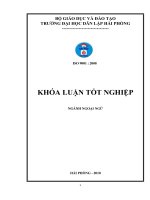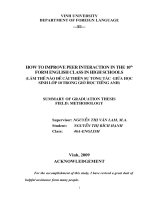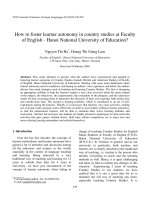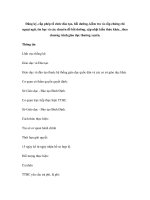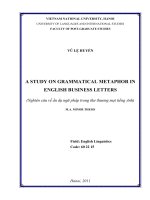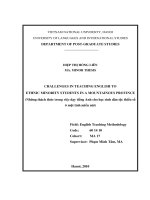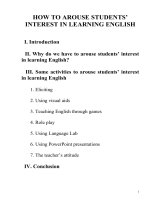HOW TO CONVEY BAD NEWS IN ENGLISH BUSINESS CORRESPONDENCE
Bạn đang xem bản rút gọn của tài liệu. Xem và tải ngay bản đầy đủ của tài liệu tại đây (257.18 KB, 43 trang )
1
PART A: INTRODUCTION
1. Rationale
The event that Vietnam joined WTO this year is so meaningful. Vietnam had
been waiting for this for a long time before it was officially a member of this
organization. This event will help our country to develop more quickly and it helps
Vietnam to catch up with the speed of economic development of other countries. It
also eases the international business transactions, which are becoming more important
than ever before. International business transactions are an effective way of
communication as they enable the communication of every country in the world. The
international business communication is very important. Lockers (1992:14) states:
“Good communication is worth every minute it takes and every penny it costs”.
Business communication can be taken in the form of face-to-face meetings or of
written communication known as business correspondence. Business correspondence
takes a very large share in business communication as business associates who desire
transactions quickly are in different distance places and are unable to frequently travel
a long way for every single business discussion.
Every businessman would like their business to run smoothly without any
troubles as company closed down, orders are refused or complaints are made.
However, it is too perfect business. In business transactions, it is common for
businessmen to write business letters that convey bad news. Bad news certainly
displeases readers and may cause destruction in relationship between business
partners. Therefore, knowing how to write a good letter conveying bad news is
essential for the survival of a business.
With the hope of finding out how English writers write bad-news letters, the
writer does hope that her findings will be very useful for everyone who cares about
bad-new business English letters.
2. Aims of the study
The study aims at
-
Studying the ways to convey bad news in English business correspondence;
-
Finding out some strategies in conveying bad news in English business
correspondence;
2
-
Studying the way to convey bad news in some kinds of letters: letter of
rejecting a complaint, turning down a credit and refusing an order to help the
teaching and the learning of commerce English…
-
Finding out how to create goodwill in conveying bad news in English business
correspondence.
-
Giving some implications in writing a good bad-news letter.
Research Questions:
1. How do English writers convey bad news in English business correspondence?
2. Which strategy is preferred in conveying bad news in business letters?
3. How do they write to create goodwill in their bad-news letters?
3. Methods of the study
This thesis uses the methods of description, analysis, and statistics in linguistic
study.
A number of materials on applied linguistics, notably on speech acts and
politeness strategies are studied to build up a theoretical background for my thesis.
Data used in this thesis are mainly collected from textbooks and authentic English
written by native English speakers. The writer also uses a plenty of business letters in
the book Oxford Handbook of Commercial Correspondence published by Oxford
University Press in 2003, written by A. Ashley.
4. Scope of the study
This thesis focuses on how to convey bad news in English business
correspondence only. It describes common goodwill techniques in writing English
business letters.
Three kinds of bad-news business letters are analyzed are:
-
Letters of refusing a complaint
-
Letters of turning down a credit
-
Letters of refusing an order
From the writer’s point of view, these kinds of letters are the most likely to cause
Face Threatening Act (FTA) to readers who may have negative attitude towards the
messages sent. However, during everyday business transactions, bad-news messages
3
are always available in the three kinds of letter. What is more, time and reference
constraints are also the barrier for the extension in the scope of the study. For the
reasons above, the writer only focuses on the above-mentioned matters in her
research.
5. Design of the study
Part A is an introduction presenting the rationale of the study, the aims, the scope, the
method and the design of the study.
Part B consists of 3 chapters:
Chapter 1 presents the theoretical background of this work. Firstly, the notion
of, and the background of speech acts are provided. The emphasis will be on
dimensions and types of speech acts, face and politeness and the act of breaking bad
news.
Chapter 2 is the study which deals with how to convey bad news in English
business correspondence. Some strategies are employed in direct and indirect
approaches and some findings are given out.
Chapter 3 provides implications to write bad-news letters.
Part C is the conclusion, the summaries of the whole thesis.
4
PART B: DEVELOPMENT
CHAPTER ONE: THEORETICAL BACKGROUND
1.1.Speech Acts and the act of breaking bad news
Speech Act theory was originally initiated by the Oxford philosopher, J. L.
Austin in 1930s and was expounded in a series of lectures which he gave at Hardvard
in 1955. In his book How to do things with words, Austin argues that when we use
languages, we are performing certain acts.
Traditionally, philosophers have to
distinguish between actions and speaking; on the basis that speaking about something
is quite different from doing it. For example, a woman says, “ It is very hot in here”.
She doesn’t want to inform that it is hot but want the listener to open the window or
turn on the fan.
Those kinds of actions via utterances for the purpose of communicating are
called “speech acts”. In English, they are commonly given such specific labels as
apologizing, complaining, requesting, inviting, informing, complimenting or
promising etc.
Breaking bad news is a kind of speech act. When speakers break bad news,
they are performing an act, that is the act of informing bad news Bad news is a kind of
news that makes hearers sad, unhappy or bad. Nobody welcomes bad news. And thus
the act of breaking bad news is an act to say something that disappoints hearers and
makes hearers displeased, disappointed and depressed. For this reason, speech acts
theory will help the writer a lot in her study.
1.1.1. Dimensions of speech acts
Speech acts are defined by Hymes (1972) as the acts we perform when we speak –
such as agreeing, complaining, requesting, apologizing, promising, approving,
informing and so on. Austin believes that a single speech act actually contains three
separate but related acts: locutionary acts, illocutionary acts and perlocutionary acts.
-
Locutionary act: When making an utterance, a speaker performs a locutionary
act, an act of saying something, with a sense and reference. It is simply the act of
producing a linguistically well-formed, and thus, meaningful expression. For
example: When making an utterance of breaking bad news, a speaker performs a
5
locutionary act, an act of breaking bad news. This utterance used in breaking bad
news is meaningful because it informs bad news.
-
Illocutionary act: The illocutionary act is the function of the utterance that the
speaker has in mind, the communicative purpose intended or achieved by the
utterance. For example: When a speaker performs an act of breaking bad news, the
speaker thinks that the news informed is bad and the communicative purpose intended
is achieved as the speaker breaks bad news in his/her utterance.
-
Perlocutionary act: the perlocutionary act refers to the hearer’s recognition of
the illocutionary act. As a consequence, the hearer may feel amused, annoyed,
displeased, surprised, or pleased. For example: In uttering an act of breaking bad
news, the speaker thinks that the hearer may feel annoyed or displeased when being
informed the news.
Speech acts tend to concentrate largely on illocutions, locutions and perlocutions
coming before and after the illocutionary act, although important, are of less central
interest. When Austin first began his study of speech acts, he attempted first of all to
distinguish between a class of utterances which he called “performative” and those
which he termed “constatives”. Performatives are a special group of utterances of the
saying of which actually perform the action named by the verb.
For example:
- act of marriage: I hereby claim that you are husband and wife
- act of naming a ship: I name this ship the Saucy Sue.
- act of closing a meeting: I declare this meeting closed
- act of wager: I bet you a winner
- act of apology: I apologize
- act of informing: I hereby inform you that ...
etc...
However, the act of breaking bad new tends to highly threaten the hearer’s face
and thus it is less likely to appear in performatives to avoid an FTA in uttering the
sentence.
6
1.1.2. Types of speech acts
Speech acts can be classified according to how they affect the social interaction
between the speakers and the hearers. The most basic categorization (Searle, 1969)
consists of five different types of speech acts:
1. Declaratives: are those kinds of speech acts that change the world in their
utterance. For example, the priest claims: “I hereby claim that you are husband and
wife”. This claim will change the state of the two single people to married ones.
2. Representatives: are those kinds of speech acts that state what the speaker
believes to be the case. A representative can be either true or false as the speaker
asserts, says, concludes, describes, etc. For example, “the Earth is round” when saying
the utterance, the speaker believes that the Earth is round.
3. Directives: are those kinds of speech acts that speakers use to get someone else
to do something such as commands, orders, requests, and suggestions. For example,
“Wash clothes!, the speaker wants the listener to wash clothes.
4. Expressives: are those kinds of speech acts that state what the speaker feels.
They express psychological state and can be statements of pleasure, pain, likes,
dislikes, joy or sorrow. For example: “I am lonely”, the speaker feels lonely.
5. Commissives: are those kinds of speech acts that commit the speaker to do
something such as promises, threats, etc. For example. “I will give it to you
tomorrow” is considered to be a promise. The speakers intend to do what is said.
To sum up, speech acts are the acts we perform when we speak. The speech act
theory helps to interpret the function of language in communicating, which plays an
indispensable role in interaction.
In studying the categorization by Searle, I find myself that the act of breaking
bad news belongs to representatives because when the speaker informs the bad news,
s/he believes that the news informed is true. That is why it may cause an FTA. In
informing the bad news, the speaker has to do the thing that s/he knows will threaten
the hearer’s face and certainly s/he does not want to do so. The hearer, moreover, does
not want to receive the bad news and s/he may have the negative reaction to the news
informed. If the speaker is not careful about word-choice as well as way to present the
bad news, a break in business relationship is unavoidable (see chapter 2).
7
Another way of classifying speech act, according to Searle 1969:60) is based
on the structure and the use of word. And according to him, speech act can be divided
into two opposite ways of informing something: Direct and indirect speech acts.
Direct speech acts and indirect speech acts are distinguished from each other.
Indirectness is defined as “those cases in which one illocutionary act is performed
indirectly by the way of “performing another” (Searle 1969, p60). In direct speech
acts the speaker says what s/he means, while in indirect speech acts the speaker means
more than what s/he says (Searle 1980, p.8), for example speakers perform one
illocutionary act implicitly by way of performing illocutionary act explicitly. For
example, instead of telling a student that s/he is late for the lecture, the teacher may
ask a question “What is the time now?”. That is the indirect act and the direct act is to
ask what time is.
Concerning why indirectness is used, Yule (1996, p.56) writes “indirect speech
acts are generally associated with greater politeness in English than direct speech act”.
1.1.3. Breaking bad news
Life is not always comfortable and enjoyable and it can be disappointing at
times. Problems like systems break down, mistakes are made, deadlines go unmet,
complaints and credit are turned down, orders are refused are not rare. In this case, the
speaker has to inform these problems – known as breaking bad news to the hearer. It
is not always easy to be the deliverer of ‘bad news’ to your colleagues, your
customers, or to anyone else for that matter. The act of breaking bad news is known as
a speech act as it informs bad news to hearers, i.e., it is the act of informing.
For example: when the writer says: “we can not offer credit facilities of any
kind at present owing to inflation”. In saying this sentence, the writer believes that
s/he cannot offer credit facilities.
Searle (1976, p.44) argues that each type of illocutionary act requires certain
conditions for the successful and felicitous performance of that act and these he calls
felicity conditions. Searle identifies four different kinds of felicity conditions:
propositional content conditions or rules, preparatory conditions or rules, sincerity
conditions or rule and essential conditions. These conditions relate, on the other hand,
8
to the belief and attitudes of the speaker and the hearer, and, on the other hand, to the
belief and attitudes of linguistic device for communication.
The act of breaking bad news should meet the requirement of Searle’s felicity
conditions, if the speaker wants to have a successful and felicitous performance. For
me, the act of breaking bad news should satisfy the four conditions belows:
1. General condition: it focuses on the background knowledge of the Speaker
and the Hearer. That is who the speaker and the hearer are. How they are related to
each other and in what aspect. They can communicate with the full understanding of
the information sent or not.
2. Content condition: In the act of breaking bad news, the message sent is badnews message. The speaker is responsible for informing the hearer of the news and
the hearer has not been informed the news yet or the speaker believes that the hearer
has not been informed the news.
3. Sincerity condition: This condition concerns about the sincerity of the
speaker when informing the news. The speaker means what s/he say and the hearer
believes in what the speaker says.
4. Essential condition: In the act of breaking bad news, the speaker has to or is
responsible to inform the news to the hearer. The speaker believes that the hearer
should be informed the news.
These four conditions are of vital importance when breaking bad news. The
act of breaking bad news is mainly to inform the news that is bad, unhappy to the
hearer. The hearer is considered not to have been informed the bad news yet. (In the
case that the speaker knows that the hearer has the information but still say out the
bad news, this is out of the question of this thesis because it is not the act of
informing).
1.2. Face and Politeness
1.2.1 Face and face-want
In everyday social interaction, to be respected and recognized, people try to keep
their public self-image, which is called face.
9
In interaction, “the positive image or impression of oneself that one shows or
intends to show to the other participants is called face” (Richard, J et all 1985:102.
Longman Dictionary of Applied Linguistic).
Face want:
Within everyday social interaction, people generally behave as if their public
self-image, or their face wants, will be respected. By doing that way, people can
maintain their face. It’s their face-work
Hudson defined that face-work is “the way in which a person maintains his
face”, which is carried out by presenting a consistent image to other people, so that
one can gain or lose face by “improving or spoiling” this image. Hudson stated that
through what one says or how to say it, the speaker presents a personal image for
others to evaluate.
If a speaker says something that represents a threat to another individual’s
expectations regarding self-image, it is described as a face-threatening act (FTA)
Alternatively, given a possibility that some actions might be as a threat to
another’s face, the speaker can say something to lessen the possible threat. This is
called a face saving act (FSA)
Besides, it should be noted that some certain speech acts flatter face such as
compliment, thanks or offer. This is called a face-flattering act (FFA).
Both an FTA or FFA might be the cause of the risk of losing face. To avoid
this risk, either an FSA should be used or greater attention should be paid to the
different use of routine and speech acts in different cultural communities.
Deriving from the theory of Goffman, Brown and Levinson (1987:61ff) we can
have two related aspects of face.
+ Negative face: the basic claim to territories, personal preserves, right to nondistraction – i.e., to freedom of action and freedom of imposition.
+ Positive face: the positive consistent self-image or “personality” (crucially
including the desire that this self-image be appreciated and approved of) claimed by
interaction.
Face-work, therefore, proves to play an important part in making a
conversation work either negatively or positively. When the face is kept, the
relationship is maintained without much difficulty.
10
When we write business letters, conveying bad news can potentially cause the
loss of the reader’s face. Therefore, breaking bad news can be considered as an FTA.
It risk to threaten news receiver’s face. Also, when we turn down a complaint, a credit
or an order, we may disappoint receivers, break the reader’s face and cause serious
misunderstanding between business partners if the bad news is not written out in a
way they save the reader’s face. This may cause the risk of breaking the business
relationship. Thus, in order to avoid this risk, politeness strategies is effectively used
to maintain face, and thus, to maintain a business relationship between the reader and
the writer.
1.2.2 Politeness
In order to maintain each other’s face, the interlocutors have to take into
account the consideration of politeness.
Politeness is defined in Collins Cobuild English Language Dictionary as
“things you say or do simply because it is social correct to do or say them, rather
than because you mean them sincerely”. What should be discussed, then, is in what
standard people can judge something they (or others) do or say means politeness, or
rather, in what view something is socially correct. This issue should be considered
under each other culture for judging things.
In accordance with two kinds of faces in Brown and Levinson’s view: negative
and positive faces, politeness is divided into two types: negative and positive
politeness. Positive politeness, according to Brown and Levinson, is concerned with
the actions people take to maintain their face and that of the other people they are
interacting with. Positive face has to do with presenting a good image of oneself and
securing the approval of others. Positive politeness consists of acts, which are
designed to preserve or restore the Hearer’s positive face, by stressing the Speaker’s
sympathy with a social closeness to the Hearer. One linguistic way of doing this
would be to link the Speaker and Hearer together by using the pronoun forms: we/us
and our
Negative politeness is the effort not to be coercive against imposition on
others, in other words, not to poke one’s nose into other’s privacy. Negative
politeness consists of acts which are designed to preserve or restore the Hearer’s
11
negative face, by expressing the speaker’s reluctance to impose his or her wants on
the Hearer. One way of doing this would be to say something like: “I don’t like to
bother you but ...” The tendency to use negative politeness forms, emphasizing
Hearer’s right to freedom seen as deference strategy. However, it should be noted that
neither negative nor positive politeness is thoroughly good or bad. This depends much
on culture, i.e. this culture is more or less in favor of the former or the latter viewpoint
of politeness as people in that country consider it to be good or bad to show concern
for or interest in each other’s business.
1.2.3. Strategies
When organizing a letter, the writer needs to choose one appropriate approach.
Below are two basic approaches (described by Bowee et all: 2001:74)
1.2.3.1 Direct approach (Straight forward)
Writers state the main ideas first and then the evidence follows. This strategy is
really useful when the receivers will be pleased, eager, interested or even neutral
when reading the letter.
The direct approach can save time for both the writer and the reader. It consists
of the three following steps
Step 1: The opening: Begin with the objective. Either a specific question or a
general request for information can be employed to state the information. Early
presentation of the objective will catch the reader’s attention better.
Step 2: The body: Give the details. If the reader needs information to answer
the question, the writer needs to include all explanation needed. When more than one
question are included in the message, they should be numbered and listed logically
with the first important question appearing first, followed by questions of descending
importance.
Step 3: The closing: Writers restate the information and ask the reader to
respond by a specific time. They also need to express their goodwill and appreciation.
The direct approach is perfect for a letter of request or a letter of conveying bad
news, as it is very clear and easy to read and draw out what is informed. It is also
timesaving as the information is presented in such a way that is very brief and
obvious. The reader likes this approach more because it is easy to get into the point.
12
1.2.3.2 Indirect approach (Roundabout)
For the kinds of letters using indirect approach, we often state the evidence
first and followed by main ideas.
There are normally four steps in presenting a letter in an indirect approach:
* Begin with a buffer. A buffer is a neutral or positive statement that is closely
related to the point of the message. A good buffer expresses writers’ appreciation for
being thought of, assures the reader of their attention to the request, compliments the
reader, or indicates their understanding of the reader’s needs.
* Give evidence: Effective reasoning convinces the audience that the decision
is justified, fair and logical. The more positive points should be stated first, then the
less positive ones. The writer should also make sure to provide enough details for the
reader to understand the reasons.
* State objectives. When the refusal is a logical outcome of the reasons that
come before it, the audience is psychologically prepared to receive it. There are some
ways to de-emphasize the bad news: putting the refusal in the same paragraph as the
reason, stating it implicitly, using as few words as possible for the bad news,
subordinating the bad news in a complex or compound sentence, burying the bad
news in the middle of a paragraph, and giving alternatives whenever possible.
* End with a positive close. A refusal letter should end with a positive,
forwarding-looking statement that is helpful and friendly. To keep it positive, the
writer should not refer to, repeat or apologize for the bad news and refrain from
expressing any doubt that the reasons will be accepted.
The indirect approach is lengthy and it takes a lot of time. However, it helps
the writer not to state the problem straight away. They have to go roundabout before
presenting the situation as they are in fear of making the readers displeased and
readers may lose their face with the news receive. In other words, the indirect
approach can help the writer to delay negative news. It allows the reader to prepare for
the unhappy news and that is why it is preferable in bad-news letters.
1.3.Conveying bad news in business correspondence
1.3.1. Criteria of business correspondence
13
In written communication, how something is said is almost as important as
what is said. Nevertheless, many writers tend to focus only on the ‘what’ of their
documents. In fact, how something is said contributes much to the success of the
business. When the recipient understands the message, and more importantly, accepts
the message, especially in conveying bad-news message, the letter is considered
effective. The below seven “Cs” describe the effectiveness of the letter.
1. Clarity: Clarity depends on the use of words. In general, the writer should
use simple everyday language and avoid technical terms when appropriate to make
sure the reader understands the message. Clarity also means organizing the letter so
that each paragraph deals with one main idea, and presenting the ideas in a logical
order.
2. Conciseness: Conciseness means saying all that need to be said and no
more. A concise letter should eliminate all unnecessary words. In business, few
people have time to read irrelevant details. For this reason, it seems that short letters
are remembered better than long one.
3. Completeness It is important that all the information needed must be
included in the letter so that the reader has enough information to evaluate the
message and act on it.
4. Correctness: Data, statements mentioned must be accurate. Correctness also
refers to the explicit identification of assumption and opinion. There should be no
error in punctuation, grammar, word order, structure, spelling and document format.
5. Courtesy: This means that we should be polite in expressing opinion and
ideas. We should respect readers. If not, the readers should be hurt. A courteous
message takes the reader’s feelings and point of view into consideration and offers
help where necessary.
6. Confidence A confident message shows the writer as a decisive, positive
businessperson. It also shows that the writer assumes the reader is decisive, positive –
a person capable of overcoming obstacles. A confident message eliminates the
implication of doubt in conveying its message.
7. Conversational tone: The language used in the letter should be warm and
natural, it is easier to win reader’s feeling and sympathy. At this tone, the message is
thoroughly understood.
14
(Extracted from Pham Thi Huong Giang-LVNNA.0161:25)
In short, these seven criteria are so important in written business communication
that it should be taken carefully when writing business letters. It becomes more
meaningful in conveying bad news – an FTA. The seven criteria: clarity, conciseness,
completeness, correctness, courtesy, confidence and conversational tone, if effectively
used, will create goodwill in the readers and construct better climate that will lead the
customer back to the organization for future business. However, how to have the
seven criteria in a bad-news letter is not easy. In normal forms of business
correspondence, the content of the letters are often stated directly as it is very clear
and brief. Whereas, letter of conveying bad news is likely to cause an FTA, it is the
tendency for writers to write the letters in a less direct way. In other words, letters of
breaking bad news seem to be written in more indirect way and it is difficult to state a
matter indirectly but clearly and briefly. As a result, this study is carried out to find
out how native English writers write letter of breaking bad news and if these letters
meet the seven criteria mentioned above or not.
1.3.2 Roles and purposes of conveying bad news in business correspondence
Communication is simply a method of sending a message from one person or
group of persons to another. It is vitally important to a business because it involves all
the persons and organizations connected with the business - employees, customers,
shareholders, suppliers, creditors, debtors - and a whole range of people outside journalists, television reporters, tax authorities, local government and national
government officials, indeed, any person or organization throughout the world with
which the business has any contact. Good communication will ensure that all these
persons and organizations understand the message sent. They will also be more likely
to respond favourably to the message if it appears to be reasonable and fair to both the
receiver and the business. Bad communication will have exactly the opposite effect.
People will be confused by the message and less likely to do what the business wants.
That is why good communication is so essential. It is not only what you say (or write),
but how you say it is important. Your message should be easy to understand and take
account of the receivers' own attitudes and feelings
15
Most enterprises do their business really successfully as they know how to
communicate with their clients. They communicate in face-to-face discussions, in
informal groups, in meetings. They may also make phone calls. They write e-mails,
memos and report. However, one of the most popular and efficient ways to send their
ideas to their clients is through business letters.
It is no doubt that business letters is more formal than any other ways of
communication. Moreover, they are more convenient for the reader to store the date
and complex information and the information is processed in a more accurate way.
They also enable the writer the present their idea in the most effective way, especially
in a very sensitive situation such as conveying bad news. As a result, the news
informed is better understood.
In short, business letters is a principal means of correspondence with three
major purposes: to transmit a message, to persuade the reader to act and create
goodwill.
1.3.3 Different kinds of bad news in business correspondence
Business correspondence is various in kinds. When we order the goods, you
write letter of order or when you apply a job, you write a letter of application.
Similarly, we have letters of offering a job, letter of complaint or sales letter…
Ideally, everything runs smoothly in the operation of an organization – no mistakes,
no problems, no defects and no misunderstanding. However, even in the bestmanaged organizations, dissatisfactions are bound to occur. When a product or service
does not meet customer’s expectation, the customers are disappointed and usually
complaint. These letters complain about wrong merchandise, slow service, invoice, or
statement that contain errors, or even discourteous treatment at the hands of
employees are expressed.
Thus, many kinds of business letters include bad news in them. For example, some
bad-news related letters are:
1. Letters of refusing a request.
2. Letters of turning down a claim.
3. Letters of refusing to complete an order.
4. Letters of turning down a credit.
16
5. Letter of providing constructive criticism
6. Letter of refusing a complaint
7.Letter of refusing a job offer.
etc...
However, within many kinds of bad-news letters mentioned above, I find that
order-related letters, credit-related letters and customer service-related letters are the
three kinds that tend to cause the most FTA to the reader. They are also the
unavoidable bad-news-related messages during business transactions. For this reason,
my writing focuses on three kinds of bad-news letter only. They are letters of refusing
a complaint, letters of turning down a credit and letters of refusing an order only.
1.3.3.1. Letters of refusing a complaint
During business transactions, customers often make their complaints when
there are anything they dissatisfy with the merchandise (as delivery is late, the good is
not in the best condition, the item they receive is not the item they order...), the
service, or billing errors, etc. To make a formal complaint, they often write letters.
The letter are called letter of complaints. These letters show that customers are not
satisfied and request receivers to do something for them. Receiving complaints is
certainly not pleased at all but complaints can help readers to make adjustment in
order to develop their company or firm.
However, not all complaints are justified as they may misunderstand the
situation. In this case, receivers can write a reply to refuse the complaints. Letters of
refusing a complaint disappoints the reader and it may cause an FTA as the reader
may lose their face when their request is not answered. Let’s have a look at the two
following examples:
Eg1. We have closely compared the articles you returned with our sample and can
see no difference between them. Therefore, in this case we are not willing either to
substitute the articles or to offer a credit.
Eg2. Our factory has now inspected the unit you returned last week, and they inform
us that the circuits were overloaded. We can repair the machine, but it will be
necessary to charge you as in correct use of the unit is not covered by our guarantee.
17
The examples show that letters of refusing a complaint threaten the reader’s
face as it is worth considering how to write in a way that it saves the reader face. (See
chapter 2 for details)
.
1.3.3.2. Letters of turning down a credit
In everyday business transactions, it is not always so perfect that the supplier
delivers the merchandise and the buyer will make a payment immediately either in
cash, by credit card or by cheque. It is frequently that the buyer will pay the supplier
sometimes later, maybe thirty, sixty or ninety days after the delivery. In this case, the
buyer has a credit.
The purpose of a letter of credit is to ask for a loan or an extension for a
payment from the supplier. In many cases, the supplier will accept the credit.
However, in many other cases, the supplier will have to turn down a credit. They have
to write a letter turning down a credit and surely this letter will convey bad news to
buyer.
In addition, an international trading transaction begins when a buyer and a
seller sign a contract that records all the elements of the transaction. The buyer and the
seller may have contacted each other through the bank. In this case, a letter of credit
issued by the bank can be extremely useful. However, the bank does not always issue
a letter of credit as it may have the ‘credit risk’. In this case, the bank denies a credit
and send a letter back explaining the situation. There may be various reasons for this.
It might be uneconomical to offer credit facilities, the bank may not trust its customers
because the customers has a bad reputation for settling accounts. Whatever the reason,
the reply must be worded carefully so as not to offend the customer.
Consider the examples belows:
Eg1. Thank you for your letter of 9 November in which you asked to be put on open
account terms. Unfortunately, we never allow credit facilities to customers until they
have traded with us for over a year. We are very sorry that we cannot be more helpful
at present.
Eg2. We regret that we are unable to offer open account terms to customers as our
products are competitively priced, and with small profit margins it is uneconomical to
allow credit facilities.
18
Eg3. We are sorry that we cannot offer credit facilities of any kind at present owing to
inflation. However, if the situation improves, we may be able to reconsider your
request.
Eg4. We have considered your request for quarterly settlements, but feel that with our
competitive pricing policy, which leaves only small profit margins, it would be
uneconomical to allow credit on your present purchases. However, if you can offer
the usual references and increase your purchases by at least 50%, we would be
willing to consider the situation.
The act of turning down a credit is clearly known as an FTA, reader may lose
his/her face as their credit is refused. Letters, which turn down a credit, are thus letter
conveying bad news. How English business correspondence writers present the bad
news to avoid losing reader’s face? The findings will be presented in chapter 2 of my
study.
1.3.3.3. Letters of refusing an order
Orders are defined as letters of inquiry about the category of the merchandise,
the quantity ordered and the date of delivery. Letters of order prove that the goods is
welcome by customers and therefore the business has achievement and progress in
manufacturing as well as in creating its own image. As a result, all businesses would
be glad if they receive many orders.
Nevertheless, it is not rare when a company refuses an order. There will be a
number of reasons for the refusal of the order. The well-known reasons may be that
the firm stops producing the merchandise, the delivery is delayed or the goods ordered
is in scarcity... No matter the reason, the supplier ought to write a letter refusing the
order. Like this:
Eg1.I am writing to tell you that unfortunately there will be a three-week delay in
delivery. This is due to a fire at our Greenford works, which destroyed most of the
machinery. Your order has been transferred to our Slough factory and will be
processed there as soon as possible. I apologize for this delay, which is due to
circumstances beyond our control.
Eg2. We regret to inform you that there will be a delay in getting your consignment to
you. This is due to the cut in supplies from Gara, where, as you may aware, civil war
19
broke out last week. We have contacted a possible supplier in Lagos and he will let us
know if he can help us. If you wish to cancel your order, please let us know as soon as
possible. However, I think you will find most manufacturers are experiencing the
same difficulties at present.
The letters of refusing an order, therefore, will convey bad news. The act of
refusing an order is called an FTA. If the refusal letters are not paid enough attention,
they may cause destruction in the business relationship. That is the reason why this
study is carried out to find how the English business writers present bad-news
messages in turning down an order (For illustration, see Chapter 2). The belows are
examples extracted from the letters collected in the study:
Eg1. We are sorry to say that we are completely out of stock of this item and it will be
six weeks before we get our next delivery, but please contact us then.
Eg2. We no longer manufacturer this product as demand over the past few years has
declined.
Eg3. Thank you for your order for heavy-duty industrial overalls. Unfortunately we
have run out of the strengthened demin style you asked for. As you particularly
specified this material, we will not offer a substitute, but will inform you immediately
we receive delivery of a new consignment. This will be within the next two months.
Eg4: We received your order for ACN dynamos today, but regret that due to a strike
at the ACN factory we are unable to fulfill it at present. We are aware that other
models will not suit your requirements, but hope that the dispute will be settled soon
and we will be able to supply you. We will keep you informed of developments.
In an attempt of finding out how bad news is effectively written by native
English business writers and how bad-news messages are presented in order to gain
goodwill and to achieve the sympathy of the reader, the writer of this thesis do a
research as presented in chapter 2. The writer wishes that her result would be more or
less useful and helpful for business letters.
20
CHAPTER TWO: CONVEYING BAD NEWS IN ENGLISH BUSINESS
CORRESPONDENCE
2.1 The study
In my study, I collect 60 letters that convey bad news. Three kinds of letters
are taken into consideration. They are: letters of refusing a complaint (25 letters),
letters of turning down a credit (20 letters) and letters of rejecting an order (15 letters).
All of these letters are written by native English writers Basing on these letters, I
come to some findings about the strategy preferred (direct or indirect strategy), the
tone commonly used (negative or positive tone) and the tendency of using some
words.
The data collected help me to come to a conclusion about how the English
writers write their business letters and which techniques they use to avoid an FTA
when they have to write a letter which breaks bad news and give some explanation for
that.
2.2. The Findings
2.2.1 Direct and indirect approach
In almost all of business correspondence, direct approach tends to be employed
to state the news. However, my study shows that direct approach appears not to match
in letters of conveying bad news. The data collected point out that only 4 letters
(6.7%) (1 letter of refusing a complaint, 1 letter of turning down a credit and 2 letters
of refusing an order) use direct approach when presenting bad news. Let’s consider
the following table:
Refusing a complaint
Turning down a credit
Refusing an order
Direct
Indirect
approach
1 (4%)
1 (5%)
2 (13.3%)
approach
24 (96%)
19 (95%)
13 (86.7%)
Total
25 (100%)
20(100%)
15(100%)
Table 1: The use of direct approach and indirect approach in conveying bad news
in English business correspondence


